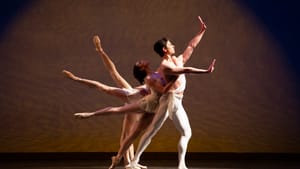Stay in the Loop
BSR publishes on a weekly schedule, with an email newsletter every Wednesday and Thursday morning. There’s no paywall, and subscribing is always free.
Master of modern ballet
The Pennsylvania Ballet presents ‘An All-Stravinsky Program’

Igor Stravinsky is as foundational to ballet in the modern era as Pyotr Ilyich Tchaikovsky is to classical ballet, and an all-Stravinsky program at the Pennsylvania Ballet in April captured his enduring essence, with help from George Balanchine, Matthew Neenan, and Jerome Robbins.
Tchaikovsky came to dance late in his career, but Stravinsky was in it at the beginning, creating scores for Serge Diaghilev’s Ballets Russes that redefined ballet at the dawn of modern dance. His 1913 music for Rite of Spring caused as much outrage as Nijinsky’s choreography. Balanchine’s Apollo cemented that relationship for a lifetime, and Stravinsky remains an inspiration to choreographers today.
An Apollonian ideal
In 1928, when Balanchine created Apollo, audiences had become exhausted by the experimental and often overwrought performances of the Ballets Russe. Neoclassicism shed the artifice of the past for an Apollonian ideal: a new dance universe of order and restraint built on the motifs of Grecian art. Apollo reflects this mood as a cool, remote exploration of beauty in shapes and forms.
Sterling Baca, in white tights and a bit of shirt draped over one shoulder, performed the title role in front of a cerulean backdrop on a stage decorated with just a low wooden stool. Baca danced with a long-necked lute, striking poses that seemed to leap from a Grecian mosaic. The three muses, in short white dresses, entered: dance (Terpsichore), pantomime (Polyhymnia), and poetry (Calliope). They danced together, forming circles in arabesque around the young Apollo, then each had a solo to teach him her art.
As Polyhymnia, Mayara Pineiro performed her entire solo with her finger to her lips to mark the silence of her muse—a striking image. Apollo gave us many such vivid moments, with complex shapes made more difficult by the measured pace of the dancing. In one bravura move, two of the muses hung from Baca’s manly biceps as he swung them slowly in a circle. The ladies around me swooned. I, of course, maintained my professional decorum.

A winner from Matthew Neenan
In his Deco, Neenan did an excellent job of balancing his trademark quirky playfulness with a mature work. That started with the music—“Tango” and “Piano Sonata” performed at the side of the stage by Martha Koeneman on solo piano—but the orange costumes, against an orange background, gave warmth to the pared-down whimsy.
The tango set the theme—women tangoed with women, men with men. Leg flicks appeared unexpectedly during the "Sonata" section. Neenan mixed humor with soaring technique, including arabesque penchées that seemed to reach for the stars. I am looking forward to seeing this one again.
A study in contrasts
Balanchine’s piece to the Stravinsky Violin Concerto is not my favorite. Frankly, the ensemble sections are a bit boring. The two pas de deux, however, are a wonderful contrast of moods. The first is almost contentious, marked by Dayesi Torriente’s backbends, a series of bridges in turns across the stage. Later, she somersaulted slowly across Ian Hussey’s back in an elegant backbend that echoes the earlier bridges.
If the first pas de deux is about challenge, the second is its opposite. The dancing was sharp, but Arian Molina Soca and Nayara Lopes impressed me most with the warmth of their connection. In these two very different dances, Balanchine seems to capture the spectrum of relationships.

A darker side
The Cage, by Jerome Robbins, was my favorite piece of the night—though I’m a little worried about what that says about me. The music, Concerto in D for Strings, is Stravinsky at his edgiest, and the dance takes no prisoners in the mindless aggression of its otherworldly female creatures.
The curtain opened on a disorganized web of ropes above the stage. The women entered with shaggy hair and costume designer Ruth Sobotka’s bodysuits, painted to look like insects. Their movements were angular; their hands, in particular, seemed to move like the claws of insects. They circled the novice, performed by Oksana Maslova, who emerged with slicked-back hair as if still damp from the cocoon. Her nestmates encouraged her instinct to murder a male intruder, and poor Ian Hussey was dispatched in short order. A second intruder, performed by Zecheng Liang, won from her a lyrical pas de deux with its own peculiarities—Maslova looked out from between his legs, braced at the waist on his knees. Ultimately, however, Torriente, as the implacable Queen, prevailed. The novice and her nestmates destroyed him as well, and kicked him across the stage just to be sure.
The almost inhuman angles of the arms give the piece much of its otherworldliness, but the most powerful thing about it is the rage that simmers below the surface of the coldly emotionless insect-dancers. I was surprised to discover that such dark, cold anger, presented without comment or censure in a dance, is uniquely seductive.
What, When, Where
An All-Stravinsky Program. Choreography by George Balanchine, Matthew Neenan, and Jerome Robbins. The Pennsylvania Ballet. April 4 through 7, 2019, at the Merriam Theater, 250 S. Broad Street, Philadelphia. (215) 893-1999 or paballet.org.
The Merriam Theater is a wheelchair-accessible venue with an ADA-compliant restroom accessible by elevator. For more information about the accessibility of Kimmel campus venues, call Patron Services at (215) 893-1999 / (215) 875-7633 TTY or email [email protected].
Sign up for our newsletter
All of the week's new articles, all in one place. Sign up for the free weekly BSR newsletters, and don't miss a conversation.

 Camille Bacon-Smith
Camille Bacon-Smith